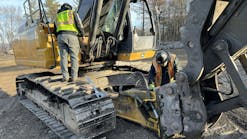The leaders of AGCO have signed the company’s largest-ever acquisition deal, agreeing to pay $2.0 billion for 85% of Trimble’s agriculture products business, which it will place into a joint venture 15% owned by Trimble. The JV will include AGCO’s JCA Technologies division.
Eric Hansotia, AGCO chair, president/CEO, said that the acquisition and JV will give his team a bigger portfolio of autonomy, precision spraying, connected farming, and data management products and services to help farmers become more efficient and reduce their carbon footprints. The Trimble portfolio being acquired—and which Georgia-based AGCO will distribute exclusively—comprises 900 employees who make and market displays, steering motors, software, and more. The business has sales in more than 70 countries and is on pace to generate $535 million in sales and $170 million in EBITDA this year.
“This landmark transaction accelerates AGCO’s strategic transformation and creates a unique platform in the global ag market,” Hansotia said on a conference call discussing the planned deal. “[We’ll] support the delivery of disruptive technologies that cover every aspect of the crop cycle.”
Were they one business today—the transaction announced this week is expected to close in the first half of next year--the AGCO and Trimble ag divisions would have revenues of more than $1.3 billion. Hansotia and his team think they can weave together the product portfolios and increase cross-selling to farmers. They see sales growing to $2 billion by 2028 while doubling that $170 million EBITDA figure, thanks in part to an envisioned $100 million in cost savings by 2027.
AGCO’s leaders have been investing heavily in recent years to add technology capabilities to their portfolio of tractors, combines, self-propelled sprayers, and other equipment. They acquired the JCA business being added to the Trimble JV in the spring of last year for about $49 million. Winnipeg-based JCA designs electronic systems and software development that automate and control agricultural equipment.
“There’s almost no redundant features between the two portfolios,” Hansotia said on the conference call. “Even in the area where, in some cases, we’ve both been pursuing a given project, we’ve been pursuing different elements of the project. This is almost entirely additive in terms of product portfolio and similarly for geography.”





